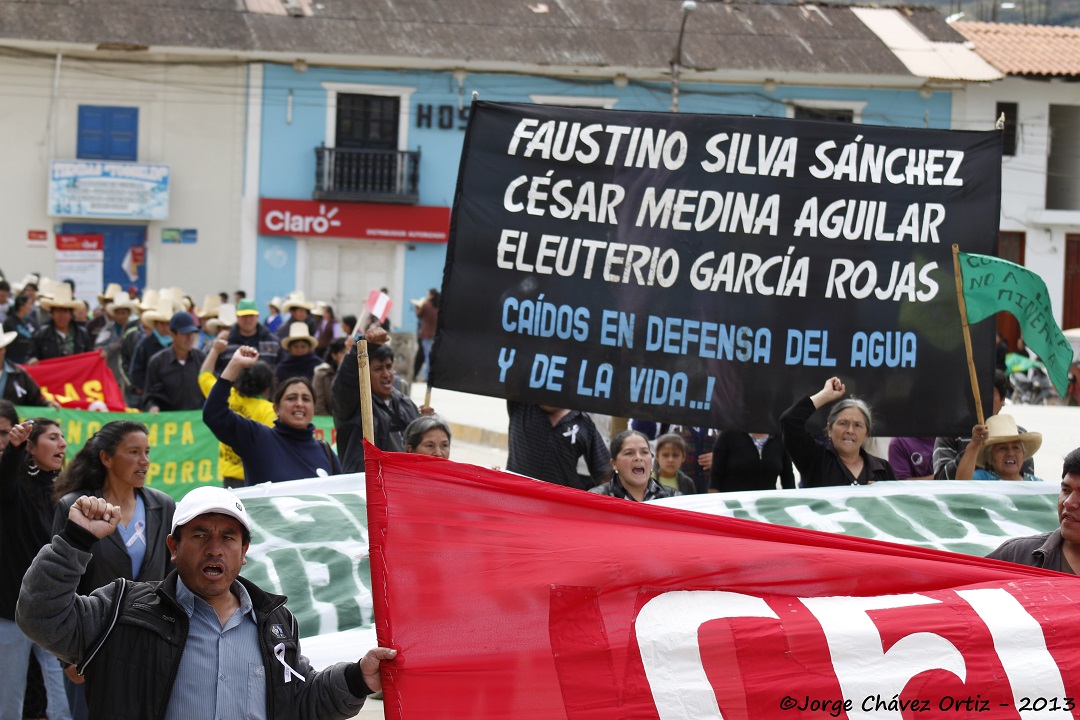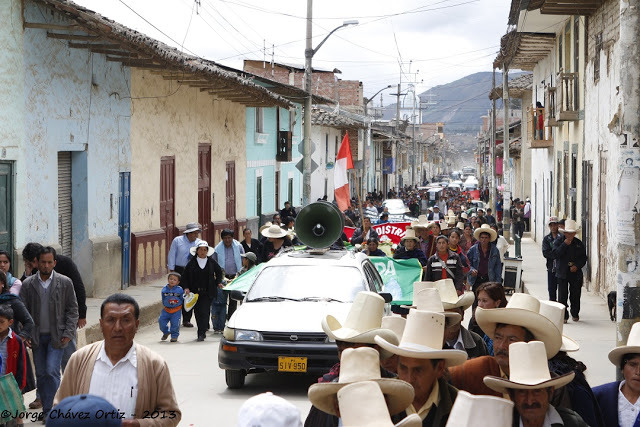[Links are to Spanish-language pages except where noted.]
One year after the anti-mining protests in the Cajamarca region [en] of northern Peru, those responsible for the deaths of five civilians during confrontations between protestors and police have yet to be identified.
On 3 July 2012, the city of Celendín was facing day 33 of a work stoppage organized as part of several protest measures against the Conga [en] mining project in different cities across Cajamarca.
That day a group of people seized the Celendín town hall, which resulted in clashes between demonstrators and the police. Initially, there were only reports of two injured police officers, which the Ministry of the Interior qualified as “criminal acts” brought about by “bad leaders,” according to then Prime Minister Óscar Valdéz.
However, it was discovered later that the confrontations [en] had left three dead and some 30 injured on the civilian side as well as two police officers and three members of the army wounded on the law and order side.
Damage to the offices of the Government and the Public Prosecutor as well as to private property were also reported. As a result, a state of emergency was declared in the provinces of Celendín, Cajamarca and Hualgayoc; it lasted two full months.
Eleuterio García Rojas, César Medina Aguilar, José Faustino Silva Sánchez and José Antonio Sánchez Huamán died on 3 July 2012 in Celendín; the next day Joselito Vásquez Jambo died in the town of Bambamarca. As of today, those responsible have not been found and justice has not been served.
A year since the deaths in Celendín
On this first anniversary, the community of Celendín gathered in the streets to peacefully commemorate the 3rd of July, now known as the “Day of Resistance and Dignitiy in Celendín”.
Approximately a thousand ronderos [members of a neighbourhood patrol] marched through the streets of Celendín “demanding the federal government and the Yanacocha mining company show more respect for local populations who do not want mining activity and that they investigate and punish by legal means those truly responsible for the murder of four citizens of Celendín,” according to the Cajamarca Global website.
A number of European organizations that support the Cajamarca protest against the Conga mining project issued a statement expressing their concern for what had occurred and the continuing situation:
Visto que el proyecto Conga no tiene la licencia social del pueblo de Cajamarca, estamos muy preocupados por la criminalización de la protesta social en Cajamarca. Condenamos el uso desproporcionado de la fuerza por parte de la policía y las fuerzas armadas, condenamos la estrategia de criminalización por medio de la cual los ciudadanos son detenidos arbitrariamente y procesados. El pueblo tiene el derecho a manifestarse y pronunciarse. Por eso insistimos que el Estado peruano garantice estos derechos.
Given that the Conga project does not enjoy the support of the people of Cajamarca, we are very concerned about the criminalization of public protests in Cajamarca. We condemn the disproportionate use of force by the police and armed forces; we condemn the strategy of criminalization by which ordinary citizens are arbitrarily arrested and accused. People have the right to protest and make their voices heard. For this reason we insist that the Government of Peru guarantee such rights.
Wilder Sánchez Sánchez recalls what happened in the blog Punto de Vista y Propuesta, through a summary of the activities organized by different groups in the cities of Celendín, Hualgayoc and Cajamarca:
El miércoles 3 de julio se cumple un año de la masacre en la ciudad de Celendín y el jueves 4 un año de la masacre perpetrada en Bambamarca por las fuerzas combinadas del Ejército, de la Policía “Nacional” convertida por el Gobierno Central en fuerza mercenaria al servicio de Yanacocha y por los propias fuerzas de seguridad de la minera (infiltrados en) y camuflados de policías. Como se recuerda, el 3 de julio del 2012 fueron acribillados por disparos de balas de largo alcance cuatro celendinos, además de numerosos heridos, golpeados, detenidos, perseguidos y judicializados.
Wednesday, July 3rd, was the first anniversary of the massacre in the city of Celendín; and Thursday, the 4th, a year since the massacre in Bambamarca through the combined efforts of the army, the federal police—turned into a mercenary force in the service of Yanacocha by the federal government—and the mining company's own security forces (infiltrating) and disguising themselves as police. As we remember, on 3 July 2012, four Celendinos were shot by long-range weapons, in addition to several others being injured, beaten, arrested, persecuted and dragged through the courts.
Jorge Chávez Ortíz, a university student from Celendín, reported on the blog Mi mina corrupta (My corrupt mine) about the vigil that took place on July 2nd in honour of the fallen:
En la vigilia se hizo la presentación del corto documental “La Tierra clama Justicia” elaborado por la PDTG con el apoyo de DOCUPERU y ACSUR Las Segovias, como también se presentó un vídeo elaborado con los diferentes mensajes enviados de varias partes del mundo solidarizándose con el pueblo de Cajamarca, se contó con la participaron varios artistas celendinos del campo y la ciudad.
In the vigil the short documentary “La Tierra clama Justicia” (the Earth Calls for Justice) by the PDTG with the support of DOCUPERU and ACSUR Las Segovias was presented along with a video of the different messages sent from around the world in solidarity with the people of Cajamarca and the participation of various Celendino artists from the countryside and the city.
In the blog Celendín Libre, Jorge Chávez recounts how July 3rd was commemorated in Celendín:
ese día de recuerdo inicio con una misa en la iglesia matriz de dicha ciudad, esta misa fue en honor a los fallecidos del 3 de julio de 2012, la iglesia estuvo a su máxima capacidad, mientras la gente esperaba en la plaza de armar. Luego de la misa se realizó una movilización, iniciando con un plantón en la municipalidad de Celendín, donde la madre de José Sánchez Human, increpo a los policías que custodiaban el inmueble, mientras les enseñaba la foto de su hijo. Luego la movilización recorrió las calles de la ciudad rumbo al cementerio general “Sagrada Familia”, donde se encuentran las tumbas de las 4 personas.
the remembrance day began with a mass in the city's main church; this mass was in honour of the three victims of 3 July 2012; the church was packed, while people waited in the central square. Afterwards a rally took place, beginning with a protest in the town of Celendín, where the mother of José Sánchez Human admonished soldiers guarding the building, showing them a photograph her son. Later the rally moved on through the city streets in the direction of the “Sagrada Familia” cemetery, where the four people are buried.
A few days before, YouTube user GeneroyMineriaPeru uploaded a video that showed several women who took part in the protests against Conga en Cajamarca, each in their own way:
Blanca nos presenta la vida campesina en Cajamarca desde su comunidad, desde su ser rondera y amante de su territorio, bañándose con Aguas de Libertad. Amalia, desde la ciudad, nos trae Memorias de Fuego caminando por los recuerdos de la lucha que unió a diferentes provincias alrededor de las ollas comunes en defensa de sus lagunas. Keyth se levanta por una Tierra que clama Justicia recorriendo las calles de Celendín, rastreando respuestas, combatiendo la impunidad.
Blanca shows us rural life in Cajamarca from her community, where as a rondera and lover of her region, she bathes in the Aguas de Libertad [waters of freedom]. Amalia, from the city, brings us Memorias de Fuego [memories of fire] wandering through the memories of the struggle that united different provinces around shared cooking pots in defence of their lakes. Keyth stands up for a Tierra [earth] that cries out for justice as she moves through the streets of Celendín, tracking down answers, fighting against impunity.
The Plataforma Institucional Celendina (PIC) published a manifesto calling for a day of dignity for Celendín, which was reproduced on the blog Sin Patrones. The manifesto ends with the following oath:
Juramos por la sangre de nuestros hermanos caídos y las lágrimas de nuestras madres y nuestros padres, por la tierra que nos vio nacer y donde descansan nuestros muertos, por las aguas y las plantas y los animales que nos acompañan y con los que vivimos, por el aire que respiramos y por el país grande en que vivimos que es el Perú pero es también el mundo, que vamos a resistir ante el invasor sin usar violencia pero con toda firmeza hasta que la amenaza sobre nuestras vidas y la de nuestros hijos e hijas y contra el futuro que anhelamos, ya no exista más.
We swear by the blood of our fallen brothers and the tears of our mothers and fathers, by the earth that gave us life and rest for our dead, by the waters and the plants and the animals that surround us and with whom we live, by the air we breathe and by the great country in which we live, the country of Peru but also the world, that we will resist the invader without recourse to violence but with absolute determination until the threat to our lives and that of our sons and daughters and the future we long for no longer exists.
In the end we are left with the moving testimony of Mrs. Adelaida Tabaco, widow of Eleuterio García Rojas, of how she experienced those terrible moments a year ago and how her life has been altered ever since.










1 comment